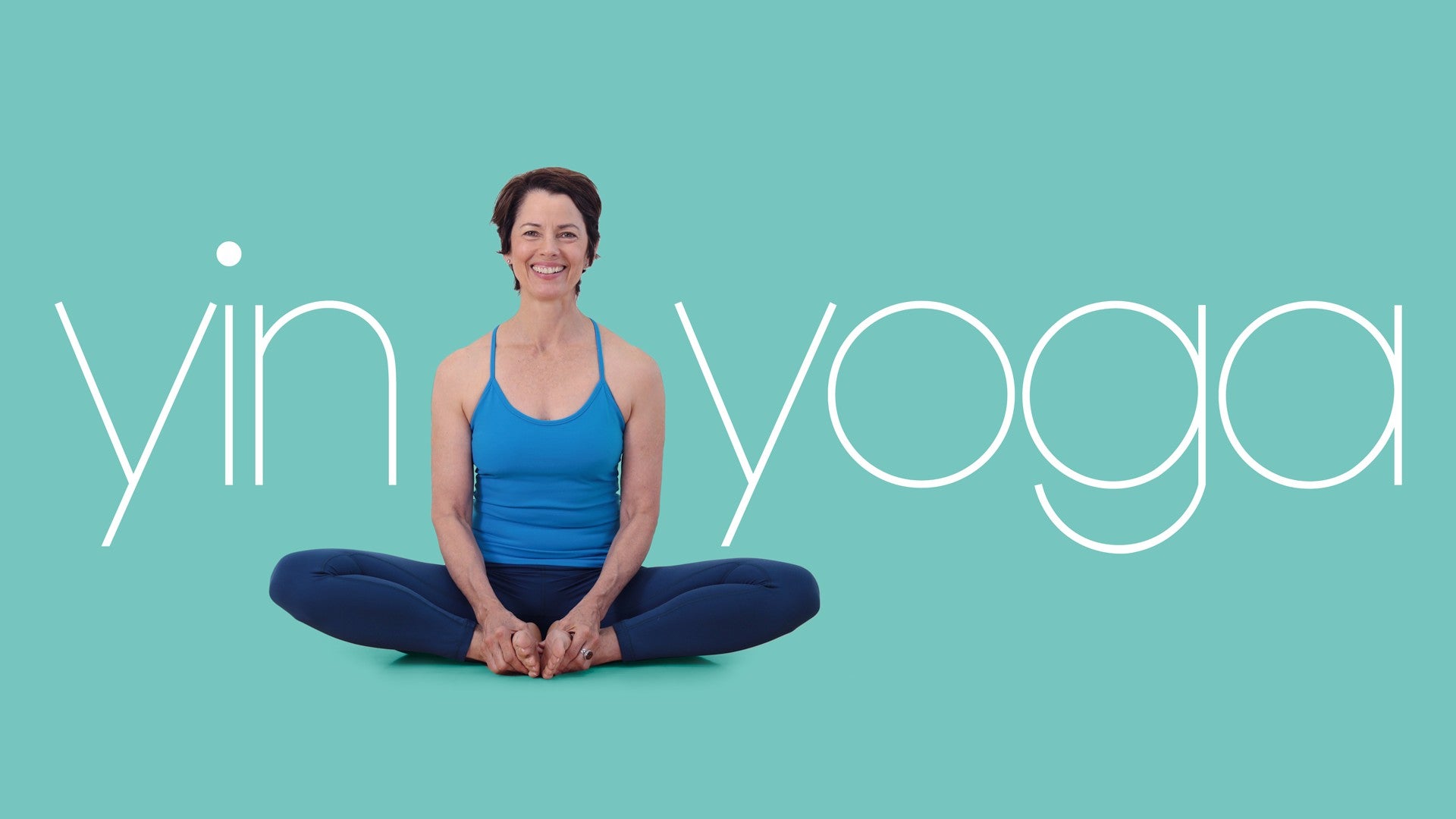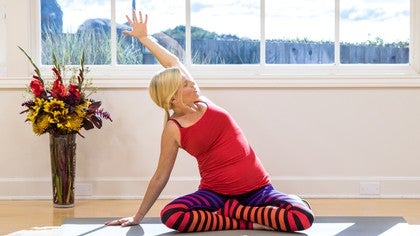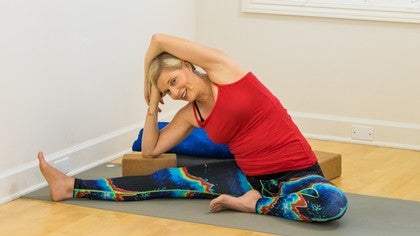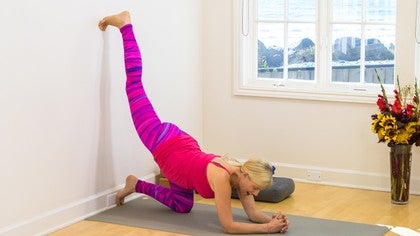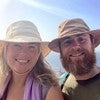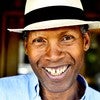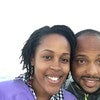Description
About This Video
Transcript
Read Full Transcript
Hi, y'all. So let's release some neck and shoulder tension. So we're going to start in a seated position. I'm sitting on a block. You could sit in a cross-legged position as well.
Just find a comfortable position and an upright spine. And then as you're ready, start to extend your arms forward, and we're going to take finger fans. So we'll start with the pinky finger, and you'll just fold in your pinky finger and then just follow with the next fingers. And then fold it all the way in, bend the arms in, and then you're going to lift the arms up and push out to the side. So really pushing through the wrists and feel that openness in the arms.
And then we'll take it again. So pinky and then folding the fingers in. You can kind of feel yourself roll in through the biceps. Lift the elbows if you want to, and then push forward. We'll do this a couple more times.
So fingers rolling in, getting that nice stretch in the wrists as you roll in. Elbows can lift up. You're moving the upper arm bone in the joint and then push out to the side. And then take it again, bending the fingers in, curling in, and then pushing forward. Let's do one more together, and as you push forward, you certainly can move a lot more as you want.
So arms can lift up and you can kind of open through the front of the chest and then push out to the side. Make sure you're breathing and then bringing the fingers back in. Last one, up, and then push forward. Nice, and then we're going to take some swimming movements with the arms. So I'm going to start with just a forward stroke, just getting the upper arm bone to move in the joint.
We forget that a lot of our shoulder tension and neck tension is connected. And then I might, I actually prefer backstroke. So if you liked the forward stroke, keep going. And notice I'm not making my spine stabilize, so I'm letting the arms really move. I'm letting the spine move.
So I'm feeling it not just in the shoulder, but in the torso. And then you might do both arms. It's almost like you're swimming a butterfly. And I'm actually really letting the torso move too as I do this, almost in like a cat and cow movement. And we'll take a couple of backstrokes.
So just feeling, and as you backstroke, sometimes it feels nice to bend the elbows into like cactus arms. So just opening through the front of the body. And then we'll just bring the hands back to the thighs and we're going to do a couple of stretches specifically for the neck. So we're just going to take a minute in each position. We'll do right, left, and center.
So I'm going to take my head over towards my right ear, towards my right shoulder, in just about a minute here. If you wanted to let your left hand drop off to the side, you could. And notice I'm not using my right hand to pull or crank in the neck area in any way. I'm really just letting gravity take over. Letting my left arm just dangle down and I feel this actually all the way down my arm.
Maybe you do as well. And you certainly can move the chin and little micro movements until you, it's like you're tuning the pose. But I would try to find a place where you can linger and the stretch feels like it's working. Relax the eyes. I'm saying that as much for me as for you.
And then just start to bring the head back to center. Be really gentle at this point and we're going to take it over to the other side. So left ear towards left shoulder, you could let your right arm just kind of fall off your lap. And I tend to hold a little more tension in my right shoulder so you might be the same with one of your shoulders. So just really concentrating on letting that shoulder drop away.
In other words, as I drop my left ear towards my left shoulder, my right shoulder wants to lift up quite a bit. So I'm going to really, I'm just going to encourage it down mentally. I'm not doing anything with force physically. Relax the eyes, the jaw. You might even separate the back teeth or notice that your tongue might be at the top of your mouth.
So release the tongue from the roof of the mouth. Breathing into the right side of the neck and again if you need to move the chin a little bit just to tune the pose, you're looking for the static in these poses. You're not looking for a clear picture. And then you're going to bring the right hand back to the lap, gently bring the head back to center and then we'll drop the chin straight down the center. So chin towards the chest for about a minute.
What I might encourage you to do here is to stay here for a few breaths but then if you'd like just start to give a little movement. So right ear towards right shoulder and then chin back towards the chest, left ear towards left shoulder. So we're making more of like a horseshoe movement but if it feels okay and you don't have a lot of neck injuries or issues you might take the head all the way up and around. So big circles with the head and the neck if that feels comfortable. Remember this is part of the body, part of the spine, the cervical spine, the neck where there's the bulk of the spinal cord, the nerves haven't branched off.
So this is a place to be really mindful of. You don't want to be aggressive with this stretch. And I usually just end with a few breaths with the chest back in the, the chin back to the chest, so back at the center, really stretching through the back of the neck. And I actually feel this all the way down between the shoulder blades. And then if you want you could just drop your chin even towards your chest and curl in for just a moment and then just start to lift back up.
So a little bit of a deeper stretch we're going to come into next called broken wing. You certainly can adjust your position if your legs are getting tired or you need to change. But I'm going to bring my right arm behind my back and grab on to my, like my right elbow but you could also just grab on to the right wrist. And then I'm going to drop my left ear towards my left shoulder. So broken wing and you certainly could just let that right arm fall down or you can tuck it behind the back.
So like I mentioned earlier, we're here about a minute, what I mentioned earlier is that in these poses we're not looking for a clear picture, we're looking for the static, meaning that we're looking for a place where the body feels like it needs us to linger. So tune the pose with micromovements of your own bones. And I'm reminding you as much as me to relax the face. As we get into this neck tension area, the jaw can clench, the eyes can get really tight. You might even drop your chin more down towards your chest for the last few breaths and just really feel that.
And then start to bring your head back up to center, release the arms. You might pause for a second, so notice I'm starting to move a little bit slower because I'm getting a little deeper into these movements. It makes you sometimes a little dizzy, just take your time, I'm going to now bring my right arm behind my back and grab onto the inner left elbow. You also could just grab onto the left wrist and I'm going to drop my right ear towards my right shoulder. So you might twist the head a little bit, remember, and bring more chin towards the floor as opposed to ear towards shoulder.
Looking for that place that just feels like it's your spot. It's the spot where you're holding tension. And I don't think these poses need to be done symmetrically side to side. So my head is in a very different position on this side and maybe yours is as well where you feel like you're getting into a different part of the neck that seems to be tense on this side. I can already feel my breath deepening a little bit.
The deepening of the breath just shows us that we're maybe calming down. Breathing in the head back to center, really gentle at this point because the head's almost like a bowling ball right now. It might feel really, it could either feel light and floaty in that dizzy way or it could feel kind of heavy. But just try to find that place where the head feels like it's balanced on top of the spine for a moment. So we're going to come into a movement that's a little bit deeper into the back of the neck.
So I'm going to come off the block and I'm going to move that off to the side and I'm going to come onto all fours. So if you've been in this position with the legs crossed or the knees bent for a while, it might feel good to extend the legs back behind you and just push back into the heels for a moment and just let the blood supply come back into the legs again. And I'm going to even take a little quick down dog. You certainly could do like cat and cows, but I'm just going to peddle out the feet a little bit. This is a down dog.
If it feels comfortable, can be a really nice way to stretch the head and the neck too. Maybe not for everybody, but letting maybe you feel that when you come into down dog, if you really let your head drop down, you get some nice traction on the neck. So don't worry so much about heels touching the floor or anything. Just try to let the head and neck relax and then just shift back forward. Let's come on to all fours and we're going to come into a pose called rolling panda.
So you'll come onto the all fours position. I'm going to tuck my, it's like I'm threading my right arm under my left arm, kind of like a twisted child's pose and I'm just going to rest my right shoulder down on the mat. You might stay here. This is a good option for people if this feels like it's enough, but I'm going to extend my left leg out to the side. So I'm going to bring my left leg out and just kind of anchor through that left foot.
You notice I don't have my left heel down. That doesn't matter. And so we're going to be here about two minutes. So this pose is one where you really have to pay attention to your own body and find the place that feels right. So what I'm starting to do now is rock forward a little bit.
And what I'm targeting, I'm trying to get into the trapezius muscle, which is this muscle, you might be feeling it between the shoulder blades. You might feel it up a little bit into the back of the neck. So some people like to bring their arm behind the back. Some people like to walk their hand more forward. This I'm using my left arm, I'm using it as a guide almost.
Now as I get a little bit deeper, I'm starting to take my gaze maybe up more towards the ceiling. You might be doing the reverse. You might be tucking your chin and kind of rolling more onto the back of the neck if that feels comfortable. Main thing you have to be careful about in this pose is not just taking a somersault because you can just go over. So some people almost turn this like I was saying into a little bit of a somersault position and notice I'm moving a little bit.
You certainly could be static and don't let the movement just be fidgeting. That's the main thing we need to watch for is that we're not just moving because we're restless in the mind. But instead I'm moving to find these different spots in the upper body. And I'm actually even starting to feel this in the side rib. So if you're starting to feel it in the torso, that's not a bad thing.
I'm going to bring my left leg in. You could have kept yours out of course. Just getting into the back of the arm, like I think the top of the shoulder, the delts, and then up into the back of the arm, like around the shoulder blade. And then we'll just start to ease ourselves out, so be gentle. Usually what I do is walk that left hand in a little bit and I push quite a bit into the left arm.
So I'm just letting the right arm kind of just come out by the movement of my upper body. I'm not really using the right arm too much. And if it feels okay to put some weight back onto that right arm, it might feel nice to just take a few cat and cows. That's what I'm craving right now, or you might want a child's pose. Sometimes the breath can be a little restricted in these poses.
As long as you can breathe, don't worry about that too much because it's really nice when you do come out and you get to take a nice full breath. All right, and we'll take it onto the other side. So I'm going to thread my left arm underneath, come into almost like a twisted child's pose with my hips lifted. I'm leaning onto my left shoulder and then I'm going to extend my right leg out. So I'll be here about two minutes.
The right hand, remember, could go forward on the mat if that feels good, or I'm keeping my right hand down just to stabilize. And then some of you might tuck the chin and move more into the back of the neck. That's like more of like almost you're coming into a somersault. I'm really getting more into the back of the left arm and left shoulder blade area. This pose doesn't need to be extreme.
You don't need to be going into this extreme place. So just take it easy, especially a lot of people who have shoulder and neck tension, some of us, I'm probably one of them, tend to be a little aggressive in some of the things that we do athletically. So be easy with this stretch. A nice mantra for all yin poses is to the body as I come in peace. So feeling it maybe between the shoulder blades, I'm starting to take my gaze up.
You might be tucking your chin more. Just finding that spot in your own body where it feels like you're productive but still safe and comfortable. Always you can come out of these poses early if you need to. I'm going to start to ease our way out. I'm going to bend my right knee in first.
I'm putting a lot of pressure into my right hand. So I'm using my right hand to stabilize. And then I'm going to push down into my right hand and just unravel the pose, letting my left arm come out. I'm going to go right into a child's pose after this one. So I'm going to bring my knees wide.
I'm pregnant to make room for the belly. But you might have your knees together. And just rest yourself down for a moment. Sometimes in that pose, the rolling panda can be a little dizzying to come out of. So taking a child's pose afterwards might feel really nice.
And then just start to ease yourself up. You might roll your spine up or just kind of walk yourself in. We're going to come into a snail pose. So I'm going to come onto my back. So I'm going to ease myself down onto my back.
Just take your time. Again, we're not in a rush. I don't think we should ever feel rushed on our yoga mats. I mean, we have enough places in the world where we feel rushed. So snail pose, you could just do this with, I'm going to actually show you first, you could just do this with a block under the hips and just do a supported bridge like this and then bring the legs up into the air.
So that might feel good for some of you. That could be enough. If you want to take it into like a full snail, it's like a lhasana pose. So I'm going to just boost my hips up and over. And we'll be here about two minutes.
So since I'm pregnant, this is not as maybe beautiful as it used to be, but it's got its own beauty now. So knees are wide for me, but you might have your legs straight. You might have your feet on the floor and you notice it's harder for me to talk. It's just, I mean, that's not just because I'm pregnant. That's because it's, this pose is harder to breathe in, but think of it as being as an opening for the back of the lungs.
So stretching the whole back of the body. And certainly if you have more flexibility and not a baby in the way, you might bring the legs all the way up and over, straighten the legs and really come into that full version where your toes are tucked or even toes pointed. I haven't done this a lot during my pregnancy, but it does feel good to open up the back of the body like this. The low back and a good stretch for the upper back for me. I hope you feel that as well.
You could certainly use a blanket or some padding underneath the upper back and neck if you feel like you're getting a little too bony there. And the arms could extend out as well. I'm keeping mine on my hips. And then let's start to just ease out. So I've got the block there and I know I do.
So I'm going to bring my legs down slow, however you want to do it. And then I'm going to just rest my hips on the block. If you didn't have a block there, it'd be fine. You just roll your spine down. I'll take the block out of the way in case you don't have a block.
It'll be on the same page. So a lot of times when I come out of snail, there's a warmth in my upper body like in the upper back. This is a good sign to me. It's like the blood supply got to that tense area and now there's warm blood coming back into that area. I also have a lot of students tell me that they get this spasming when they come out of snail, which scares them.
Don't be afraid of it. In fact, I'd tell you at this point to try to keep the movement to a minimum. Like resist, if you can, pulling the knees into the chest in opposition. I'm going to go ahead and extend my legs out now. I'm just really letting the body relax slowly out of that pose because it's a big pose.
I'm going to take the spine in the opposite direction now for a sphinx. So I'm going to bend my knees again and I'm going to roll over to my left side. You could roll to your right. It doesn't matter which one and I'm going to get some props. You could just do this on your belly without the props.
I'm using the props because I'm pregnant, but as I've mentioned before, I really like this version. It feels nice. So you're going to come and bring your pelvis down. So the pelvis might come down onto the floor flat or for me, it's coming onto a bolster. So just a little padding under the pubic bone and then your hands.
I'm going to keep my forearms down on the block here. We'll be here about two minutes and the reason I'm keeping my forearms down is I'm not using this so much as a back stretch or a front of the, I'm not using it to compress the low back right now or to stretch the front of the spine. More what I'm going to use this pose is for a stretch of the neck. So I'm going to drop the head down and just really get a nice stretch into the back of the neck. If you notice, you might feel this in a different place lower in the spine by dropping the head down.
So there's this beautiful muscle. It's really a gorgeous muscle. It's diamond shaped and it's on the back of the body. It's the trapezius. It attaches at the back of the skull, the base of the skull at the back of the head.
So as you drop your head forward, you're pulling on this muscle and it goes from the back of the head out to the collar bones and then down to the spine as it tapers off into the bottom of the diamond. So you might feel this between the shoulder blades, maybe even into the back of the shoulder blades, the neck, and try to just relax the entire back of the skull. Also notice if you're clenching in the buttocks. And if you don't know whether you are, try to tense your buttocks and if nothing happens then you indeed are. Just try to relax the spine, relax the pelvis.
So your final breaths here just feel like you can. You have permission to let the spine and the head really sag. It's not trying to be this pretty pose. And then we'll just start to ease ourselves out, lifting the head maybe first just to make sure you're not feeling too dizzy. And then pressing back, we're going to come into a child's pose.
So you might rest on your belly if you want. I'm going to rest in a child's pose. So I'm going to slide the bolster forward a little bit and let my head rest down on the bolster. And then we'll finish in a seated position. So you could, I'm going to sit on the bolster for this last one.
I'll get my blocks out of the way. So I'm going to come into a cross-legged position. You could go back to the position we were in in the beginning. That would be fine. But I'm going to do a cross-legged position and we're going to do eagle arms and get some stretches into the back of the body.
So I'm going to start with right under left. So threading my right arm under my left arm and it doesn't have to be this palms together prayer position anything. You're really just trying to get a grip somewhere. So get a grip somewhere. And so then once you get this position, you can already, some of you might just, this might be enough to feel a stretch in the back of the body.
You could also just grab onto your shoulders if that's too much. But if you're here and you feel like you're getting a good stretch and you maybe want to just play around with it a bit, then just drop the chest forward or the elbows forward and let the chest just collapse a little bit. And then we'll just give it a little bit of movement. Just a couple of breaths. So I like to move around and kind of spin the torso.
I'm getting into the side body as well. But then eventually I find this spot where I want to just linger. It's one spot where I'm like, yep, that's the one. And I just give it a few breaths. So really feeling this across the entire expanse of the back of the upper back.
And then just starting to ease myself out. Take a breath in between. I actually like to extend my arms out to the side and I just let my fingers relax almost like I'm dripping tension off the fingertips. And then we'll take it to the other side, left arm under. And some sort of grip or just hold on to the tops of the shoulders.
And then just let the chest drop forward. If that feels okay. So again, you could stay up and you could lift the elbows up. That might be a great stretch for some of y'all. For me, the best one is dropping forward.
That's where I really start to feel a good one. And then I'll just move a little bit. The head and neck are relaxed. So the head's like, you're letting it be a bowling ball here. You're letting it almost just ride along.
And you find that place for you specifically where it's like, yeah, that's where I need to stay. That's the spot. And just give it a few breaths, like five, maybe eight. We all breathe at a different pace. Let the head really relax.
I even just noticed in myself, my head wasn't totally relaxed. And then just start to ease yourself up, take your time. If you want to bring the arms back out to the sides, just feels good to me to open up again after having everything so tight and together. So we'll finish with a movement called Willows in the Wind. And so just getting into the upper body, I'm going to lean over to my right side, bring my right hand down and lift my left arm up and just move the left arm all around.
So you can bend the elbow, you can move the wrist and move the hand. And notice, we're going to do this about a minute each side, but notice as you do this that if you reach through one finger, it changes it. So pay attention to how you're reaching through the fingers and you can open up more towards the ceiling and get this really nice stretch across the chest. And if you'd like, you could dive that left arm under the right and curl in a little bit. Almost think nose towards your right hip bone if you're doing this.
And you round in the belly, you pull the belly back up and in a little bit, get into the upper back. And then I like to open it back up. Again, fingers, wrists move, and then just come back to center. This is a nice one because you can probably already feel when you come back to center the difference. The left side, my left side feels, it's like feels inflated.
The right side feels heavy and like it's just hanging. The left side feels like alive. So let's take it over to the other side. So bring the left hand down, lift the right arm up and then just start to stir this side up. Give it about a minute on this side as well.
And remember to move the fingers and the wrists. My father is retired now, but was a hand surgeon and I watched him do surgery and I have so much more respect for moving the wrist and moving the fingers, keeping all those joints of the hands really working. Reaching through a finger, maybe opening the chest up towards the ceiling and then tucking that right arm under if you want. Couple of breaths. Remember, think nose towards your left hip bone and pull the belly in a little bit.
So you're really rounding in this pose and then open it back up for a few breaths. You could certainly take a side bend here and then we'll just come back to center. And let's just end with about a minute or so. Nothing too long, but just finding the spine, feeling the weight of the pelvis, so it's so helpful for our head and our neck tension if we have the pelvis underneath us to support the spine. So feel the weight of your pelvis like an anchor and then maybe bring your attention to the crown of your head and feel as if you're almost lifting up through the crown of the head like the crown of the head is floating towards the surface a bit.
So to me, the pelvis is like an anchor, the head is like a buoy floating at the surface. And the spine is the tether between the two. So the spine is fluid still, it's still movable. Think more jello mold here than statue. And last few breaths, see if you can feel as you inhale that you expand outwards in all directions.
And as you exhale, you hug everything just gently back into the center line, it's almost like you're squeezing yourself like a tube of toothpaste, you get a little taller. But in no way militant and just making sure that the head feels like it's really supported by the lower body. The pelvis is strong and sturdy, upper body is light. Really nice. Thank you so much.
I'm glad you were here with me today.
Yin Yoga: Kate Smith
Comments
You need to be a subscriber to post a comment.
Please Log In or Create an Account to start your free trial.
